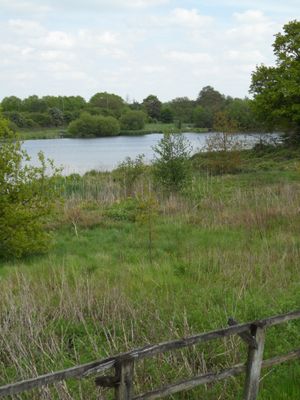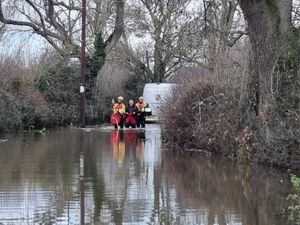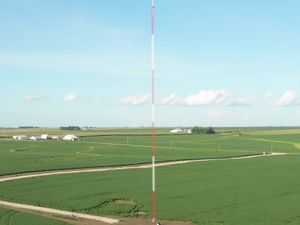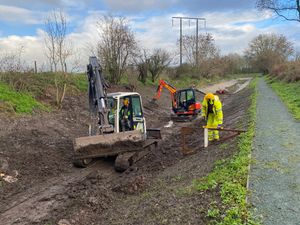When snappers flocked to find trace of ‘the Cannock Croc’
I stood, transfixed, at the barren fringes of a pool, the chocolate brown of its still, muddy waters punctuated by the slime green of algae, and waited, with an ever-growing throng, for the shallows to bubble and churn.
A group of unkempt youngsters, whose arrival at the scene had been heralded by the rusty screech of BMX brakes, dismounted their machines and began flinging the remnants of Happy Meals into the lifeless pool.
“Not the toy, Carl!” one shouted.
A portly angler seated on an unsteady folding chair – a man I’d watched, half-an-hour earlier, skewer a breaded KFC chicken leg on his hook – cast a dagger’s glance at the noisy group and scowled.
This was a truly surreal moment in time, a scene that for downright “out there” weirdness has not been matched in a journalistic career nudging a near half-century.
Steadily the crowd grew, bolstered by journalists and photographers with long lenses, until a thin ribbon of humanity gathered around modest Roman Way Pool, a place that only marginally gravitated from the label of pond. The tabloid press romantically dubbed it a lake. One paper described it as a reservoir.

They came in search of the Cannock Crocodile, a beast repeatedly spotted in the dank waters during the summer months of 2003. Those waters were actually in Churchbridge, a small community nudging the former Staffordshire pit town, but national papers had played fast-and-lose with geography from this bizarre story’s infancy.
One red-top headlined its article “Crocodile Dudley”. The BBC, no less, referred to the incident as “Cannock’s own Loch Ness”.
Exactly 20 years ago this week, the tale truly caught fire, trotted out in tabloids, on TV and radio.
We all jettisoned logic. The media, en masse, snubbed the spoilers presented by such crucial questions as: How has a full grown crocodile survived our winters? Why wasn’t it spotted before? Why has it not been seen and photographed basking on the pond/pool/lake/reservoir? What does it eat?
Unthinking pet owners liberate turtles and terrapins into natural watercourse, but what kind of householder ditches a near seven foot crocodile? I did ponder that, but decided not to let such problems stifle a bloody good yarn.
For me, the excitement and anticipation drained some two hours into my five hour “croc watch” vigil, syphoned, to a large extent, by an excitable, shrieking blonde at water’s edge called Mandy.
“Something’s poked it’s head above the water!” Mandy squealed. As a boy threw a handful of fries at the object, she pleaded: “Don’t hurt it.”
I trained binoculars on the spot pin-pointed by Mandy’s finger, sighed and testily informed fellow observers: “It’s a shopping trolley.”
Unsurprisingly, no one got the “money shot”, an exclusive picture of the creature, though many had seen it or their mate Dave swore he’d seen it or their neighbour had seen “something strange, something he can’t explain and he’s been going there for donkey’s years”.
Yet such was the scale of croc fever, local police, accompanied by an RSPCA inspector and gator expert, trawled the pool.
They may have found a shopping trolley, but certainly no killer tropical beast.
And residents were urged to stop throwing bait. The proliferation of half-eaten doner kebabs were posing a threat to the fragile eco system.
The story – and I was all over it like a livid rash from the onset – was sparked by a dad who took his children to feed swans at the spot. Something very big and sinister surfaced to gorge on the sliced bread.
He contacted emergency services and, in an odd aside to an extremely odd saga, told me he was asked to describe the crocodile by an unflappable police call handler. Maybe officers wanted to ensure they snared the right one. “Scaly, thrashing tail, looked a bit like a log at first…”
“Big teeth, huge mouth?” I asked the eye-witness.
“Yeah, you’ve got it,” he replied excitedly. “Have you seen it, too?”
Plunged into a press feeding frenzy, the father gave his version of events to the nationals: “We were there looking at the two swans and their baby cygnets.
“There was a commotion in the water and lots of turbulence. As the creature went past, I saw it had a flat head, five-foot long body and two-foot tail.
“It was not smooth and moving in a snaking action. My initial reaction was it was a crocodile or alligator.” He asked not to be named, but the statement began a domino effect of similar claims.
Linda Charteras, from nearby Cheslyn Hay, said: “I saw the creature first. A large pool of dirt came up. It looked as though it was after one of the cygnets.”
Such was the storm of stories, the Centre for Fortean Zoology (CFZ) – “a professional and scientific organisation dedicated to cryptozoology, the study of unknown animals and allied disciplines” – sent a large squad from Exeter to sonar-sweep the pool.
Its “intense”, two-day survey, failed to find the beast, although an area of flattened reeds was detected, but the subsequent operational document includes priceless eye-witness accounts. “Even as we struggled to get our trusty dinghy inflated and onto the water, the first set of eyewitnesses arrived. They were a motley gaggle of teenage boys.
“They told us that they had also had an encounter with a scaly creature in Roman View Pond. We interviewed them:
“CFZ: I gather that you’ve actually seen this animal and fed it. Could you please tell us exactly what happened?
“Lads: We came down just after the RSPCA had been here. We saw what looked like the animal in the water and so Elliot went and got some chicken and we lobbed it into the water to feed it. Some of it went too far away. But then we threw one piece and it landed just next to it and there was a massive splash and we could see both the head and the tail. We actually thought that we had seen two of the animals in the water but then remembered that there is at least one massive pike in here and that the other animal was a fish.
“CFZ: And what did this animal look like?
“Lads: It was dark and about five-feet long including the tail.
“CFZ: Did you see scales or ridges on the tail or anything like that?
“Lads: We didn’t see its tail properly but there did seem to be a few spikes."
The CFZ team did leave certain they had solved the mystery. The croc had been dumped by unscrupulous members of the exotic pet trade.
The dossier added: “Only a couple of days before we arrived the Wolverhampton Express & Star had carried a story about a large common snapping turtle which had been captured in a local brook.
“Having inspected the brook in question, and furthermore knowing that when snapping turtles achieve the size of the specimen fished out of this tiny brook in Staffordshire they are very sedentary creatures who on the whole sit on the bottom of a stream waiting for something to swim into the open mouths, I feel that it is likely the turtle was dumped into the stream in question within the last few weeks.”
That’s the smoking gun, the irrefutable evidence we were all searching for. From the start, the RSPCA investigated with an entrenched, and even jaundiced mindset. Representatives didn’t really expect to find a crocodile and they were correct.
And the animal charity had a theory over what caused the croc chaos. The creature was, it believed, a shoal of carp. The large fish often travel through water semi-submerged, giving the impression of something much bigger moving at speed through water.
And when carp mass, they can thrash dramatically. An onlooker may mistake that for something large and angry.
I left Roman Way Pool convinced it did not harbour a crocodile, yet, judging by the food litter floating on its surface, sure another killer lurked in the murky waters. Salmonella bacteria.





